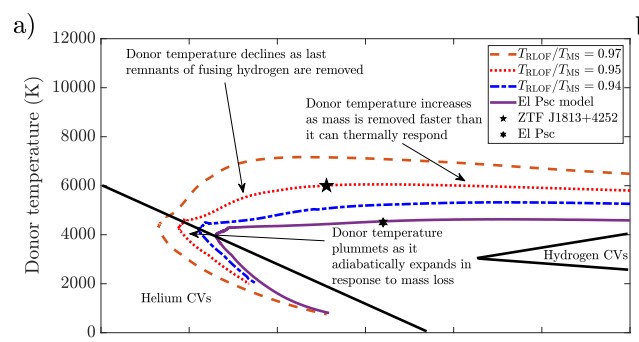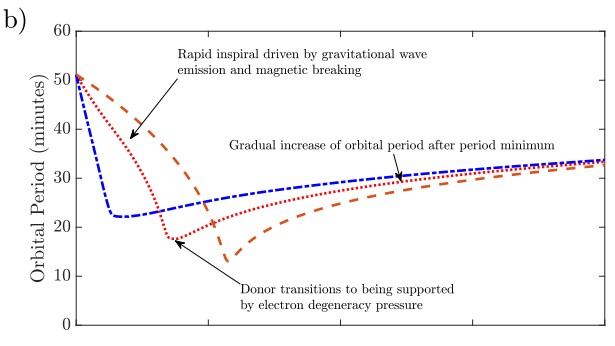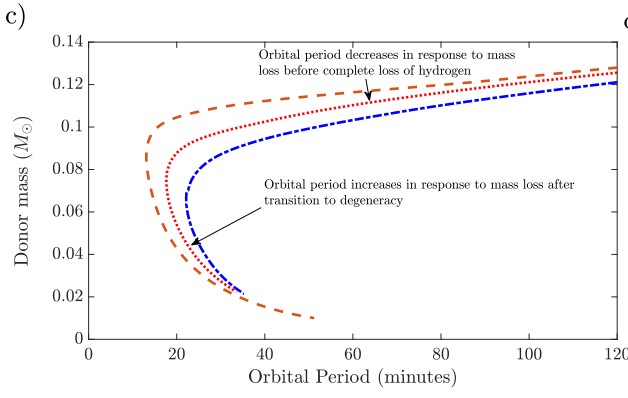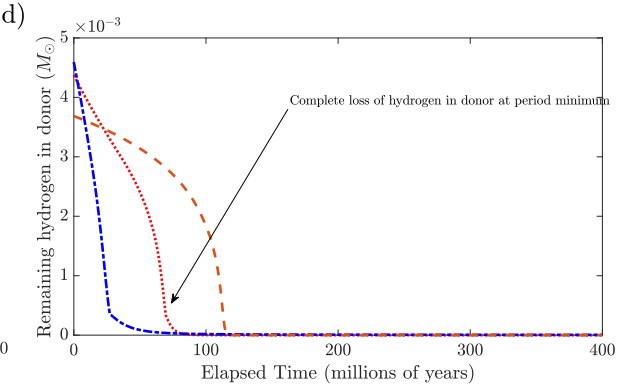We don’t have to worry too much about our Sun. It can burn our skin, and it can emit potent doses of charged material – called solar storms – that can damage electrical systems. But the Sun is alone up there, making things simpler and more predictable.
Other stars are locked in relationships with one another as binary pairs. A new study found a binary pair of stars that are so close to each other they orbit every 51 minutes, the shortest orbit ever seen in a binary system. Their proximity to one another spells trouble.
Stars this close to each other are called cataclysmic variables. In cataclysmic variables, the primary star is a white dwarf; in this pair, the other star is a Sun-like star, but older.
White dwarfs are tiny for stars, about the size of the Earth, but they’re incredibly dense. The white dwarf’s powerful gravity draws material away from its companion, the donor star. The material forms an accretion ring around the white dwarf. This process creates bright flashes at irregular or variable times as the disk heats and material falls into the white dwarf.
The stars in a cataclysmic variable (CV) must be close together for the white dwarf “vampire star” to draw material from the donor star.
Astronomers know of more than 1,000 CVs, and only a dozen of those have orbits shorter than 75 minutes. But the authors of this study found the closest orbit yet. This pair of stars needs only 51 minutes to complete an orbit. This is rare, and the binary pair is evidence of a missing link in astrophysics.
The study is “A dense 0.1-solar-mass star in a 51-minute-orbital-period eclipsing binary,” and it’s published in the journal Nature. The lead author is Kevin Burdge from the Department of Physics at MIT. The stars in this study are about 3,000 light-years away in the direction of the Hercules constellation.
These stars are at the end of a long story. They’ve been companions for about 8 billion years, though they’ve aged differently. One is a white dwarf, the stellar remnant of a main sequence star that went through its red giant phase and is now just a hyperdense, fusionless core of matter. Its companion is a Sun-like star on its way to becoming a red giant and eventually a white dwarf. But the existing white dwarf is disrupting that pathway by slowly consuming it.
The larger donor star is about the same temperature as our Sun. But it’s lost so much of its mass that it’s tiny; only a tenth of the diameter of the Sun, or about the size of Jupiter.
“This one star looked like the Sun, but the Sun can’t fit into an orbit shorter than eight hours – what’s up here?” Burdge said in a press release.
The white dwarf is even smaller; its diameter is about 1.5 times Earth’s, while its densely packed matter means it’s about 56 percent as massive as the Sun. A bizarre object.
Astronomers have discovered other eclipsing binaries, but none this close together. Not only are the pair extremely close to one another, but they eclipse each other from our line of sight. This gave the researchers multiple opportunities to observe the eclipses and to take precise measurements for both stars.
This binary pair is named ZTF J1813+4251. ZTF stands for Zwicky Transient Facility, a notable public-private partnership engaged in an optical study of the northern sky looking for transient phenomena like variables. But the name isn’t that important. Instead, it’s the particular stage the pair are in that makes scientists sit up and take note.
The researchers found that the vampire star has been stripping the hydrogen away from the donor star, and now it’s starting to cannibalize helium.
“This is a rare case where we caught one of these systems in the act of switching from hydrogen to helium accretion,” said lead author Burdge.
Observing a binary star switching from hydrogen to helium accretion is essential because the switch is a missing link in astrophysics. Astronomers know of a population of CVs called helium CVs, but there was no clear evidence of how the stars in these CVs switched from hydrogen to helium.
Before this study, the evolution from hydrogen accretion to helium accretion in helium CVs was unclear. Astronomers had never observed a star making the transition.
But the observations of ZTF J1813+4251 have changed that. Observations showed that the donor star is about the same temperature as the Sun but 100 times denser. That density means the star has a helium-rich composition and the white dwarf companion is accreting helium rather than hydrogen.
Scientists predicted decades ago that binary stars could shrink until their orbits are ultrashort and become cataclysmic variables. As the white dwarf consumes the Sun-like star’s hydrogen, denser helium is left behind. The Sun-like star burns out, and a helium core is left behind. The heavy helium core is enough to keep the dead star in a tight orbit.
The repeated observations of the stars eclipsing one another were just the beginning. With the more precise data that the

(b) shows how the binary star will reach a period minimum of about 18 minutes in about 75 million years. After that, the pair will spend the next 300 million years growing apart until its period is about 30 minutes. (The Y axis shows 100 million year increments, not labelled.)

c) shows the evolution of the donor star’s mass related to the orbital period, reaching just a few hundredths of a solar mass as the tracks evolve out to longer orbital periods as helium CVs.

d) shows how the donor loses its hydrogen on its way to becoming a helium CV. The star loses all of its hydrogen at about the minimum orbital period.

Gravitational waves play a role in this study, too. Burdge’s specialty is astrophysical sources of gravitational and electromagnetic radiation. Gravitational waves were first measured in 2015, though they’d been predicted long before that, and they’re an important area of study in astronomy. “Gravitational waves are allowing us to study the universe in a totally new way,” said Burdge.
This binary pair should emit gravitational waves at such close proximity to one another. They have to be very close together to emit the waves, but not too close; at about 10,000 km separation, they will merge and explode, ending the emissions of gravitational waves.
“People predicted these objects should transition to ultrashort orbits, and it was debated for a long time whether they could get short enough to emit detectable gravitational waves. This discovery puts that to rest,” Burdge said in a press release.
Burdge and his colleagues worked hard to find this binary pair. They scoured data from ZTF, looking for variables that repeatedly flashed in less than an hour. That signals that the stars cross each other’s orbits and that the orbital period is short. First, they used an algorithm to search through ZTF data on over one billion stars. That algorithm produced about one million stars that flashed about every hour. Burdge then looked through that selection, seeking interesting signals.
Eventually, he zeroed in on ZTF J1813+4251.
“This thing popped up, where I saw an eclipse happening every 51 minutes, and I said, OK, this is definitely a binary,” Burdge said.
“This is a special system,” Burdge said. “We got doubly lucky to find a system that answers a big open question and is one of the most beautifully behaved cataclysmic variables known.”